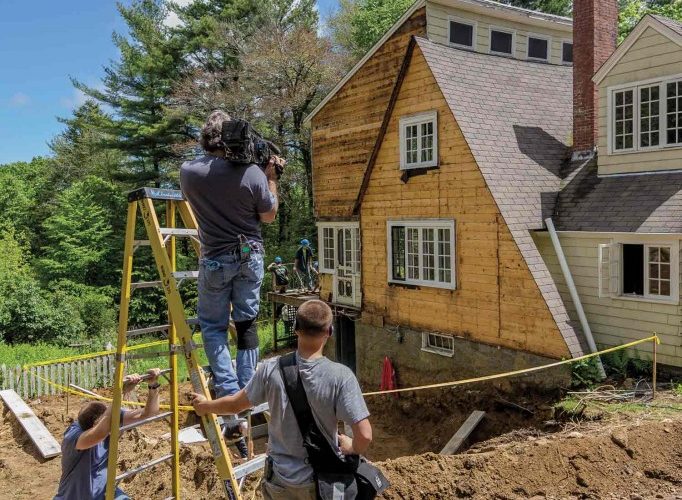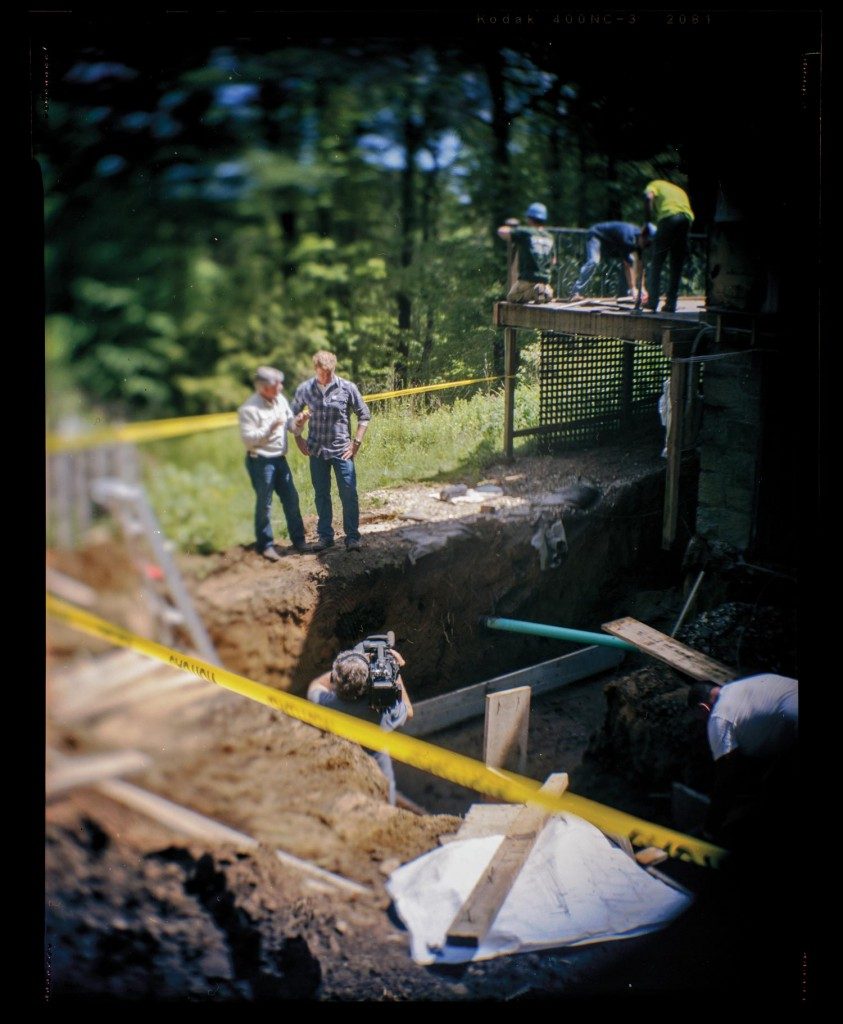This Old House tackles a special home-makeover project in Essex-a home built by John Hays Hammond, Jr.-going to great length to preserve its history and 1930s charm while adding some much-needed modern updates. By Alexandra Pecci
Tucked away in the woods of Essex, a 1930s-era house is being renovated inside and out. Already it’s been gutted, exposing beams, nails, and plenty of dust. Outside, things are just as messy; the yard has been totally dug up, and a deep hole in the ground marks the spot where foundation will be added for a new addition. It’s a construction site through and through, with work trucks and men in hardhats hauling wood, while the sound of a compressor drones from the back of a flatbed truck. Only one thing seems out of place: the camera crew.
On the house’s second floor, general contractor Tom Silva stands beneath a steeply pitched ceiling and reaches a tape measure up toward a thick wooden beam above his head.
“Now this ridge beam right here is meant to carry a load forcing down,” he explains to This Old House host (and Hamilton resident) Kevin O’Connor. Next to them, a camera crew, director, and producer watch the two men’s conversation, asking Silva to repeat his explanation again and again as cameras move around them. Silva repeats himself, and each time the wording is a bit different. On This Old House, there is no script.
This Old House, which debuted in 1979, both set and bucks the trend for home improvement TV shows. It’s real reality TV, showing the ins and outs of home renovation, from demolition to hanging the curtains. But calling the venerable 32-year-old PBS series a “reality show” would be misleading at best and insulting at worst.
“The house is always the star,” says senior series producer Deborah Hood. “Unlike other home renovation shows where there’s a lot of personal drama, ours is really about the house.”
This particular old house is being featured in the upcoming season, marking the first time the show has filmed in Essex. Like the other old houses that are renovated on the show, it deserves its starring role. The famed inventor John Hays Hammond, Jr. built the house in the 1930s as an artist’s retreat for his wife Irene. An outbuilding, which was used as an art studio, sits across the lawn and is also being restored. The small, gingerbread-style cottage is modest and charming, a far cry from the opulent, sprawling eccentricity of Hammond Castle in Gloucester, where Hammond lived, invented, and collected massive amounts of art.
For homeowner John Corcoran, CEO of the Waltham-based consulting firm Trinity Partners, knowing the house’s history is important. Although the renovation won’t set out to preserve the house exactly as it was in Hammond’s day, it will respect the house’s spirit.
“It’s being sensitive to the intent of the place,” Corcoran says, adding that, “if you’re going to go paint, I think this is the place to do itÂ…We want it to look like a cottage in the woods.”
Also important, though, is the house’s new intent: Corcoran’s mother- and father-in-law will relocate here from North Carolina in order to be closer to their grandchildren. They are, in Corcoran’s words, “getting up there in years and joining the orthopedics’ club, with bad knees and bad hips,” so the challenge will be not only to restore the house, but to create a place that’s accessible and easy to get around. To this end, architects are designing the home for total first-floor living, with all the needed amenities downstairs, including the kitchen, bedroom, laundry facilities, and a full bath. Guest bedrooms will be upstairs.
“The challenge is always to create a home that functions well for any age, but does not announce itself as ‘I’m an accessible home,'” says Sally DeGan, principal at SpaceCraft Architecture in Lexington. The renovation team will have to balance the two goals.
“What the homeowners want is to not have it look institutional,” says master carpenter and This Old House star Norm Abram. “You want it to feel like a home.” So, despite touches like wide doorways and hallways and easy access from the outside parking area, the home will still retain that charming, cottage-in-the-woods feeling.
A cottage in the woods it certainly is, and part of the restoration job involves extensive landscaping to remove overgrowth, redesign the parking area, and restore the house’s original view of the Essex River and beyond, which has been obscured by trees.
That’s the job of This Old House landscape contractor Roger Cook, who is writing notes for his upcoming meeting with the Corcorans on a yellow legal pad, using the hood of his black GMC pickup truck as a desk. “Step into my office,” he says, putting his pen down for a moment to explain his work on the property. “It’s less woodsy now than when we first got here,” Cook says, adding that they’ve also dug for the addition and done some transplanting.
The landscaping will be simple and natural looking to fit in with the wooded surroundings. Viewers who tune in will learn about adjusting grades to make the land easier to walk on and using natural materials that blend in with the environment. “People trust me to come in and totally ruin their yard,” Cook says with a laugh. The yard here in Essex certainly looks ruined; it’s totally dug up, and thanks to several days of rain, also very muddy.
But people do trust Cook-and they trust the entire This Old House team. Abram’s been with the show since it started, and Silva and Cook have each been with the show for about 25 years.
“People can trust what they watch on This Old House. They know that there’s no actors, there’s no script, there’s no pretending, and they’re learning whatever we have to offer,” says Silva. “We’re all second- and third-generation contractors. What we do is what we love to do, and we’re basically showing people what we know and how to do it.”
Silva also laughs at the notion of himself as a “star.” “I really consider myself a contractor who likes to build and work on houses [as well as] people watch,” he says.
The Essex shows will air in January; the season’s first 15 episodes are dedicated to a project in Cambridge, and the last 11 episodes will feature the Essex house. In the meantime, folks can log onto the This Old House website and watch the restoration via webcams that are set up on the job site. According to senior series producer Hood, the webcams not only give a behind-the-scenes glimpse of the show, but reinforce the fact that the “set” is actually a real, working construction site; there just happen to be TV cameras there sometimes, too.
“So what people will see is Tom Silva, more days than not, working every day,” Hood says of watching the webcams. “He brings his lunch to work and builds the house, even on days we’re not filmingÂ…these guys are tradespeople first and TV stars second.”
As tradespeople, they are deeply invested in doing their work and doing it correctly. Silva says the demolition phase of remodeling exposes “the bones” of a house, as well as the shortcomings of previous work. “Our goal is to make it right,” Abram says. For example, the crew on the Essex project is removing a shoddily built addition that, as Abram says, “didn’t seem to fit in” with the rest of the house.
“[The addition] was obviously done by someone that didn’t know what they were doing,” Silva says. “There is no structural integrity to the wall system to hold the weight of the roof. How it has lasted this long without collapsing, I don’t have a clue.”
In addition to following the home’s renovation, This Old House also highlights where each home is located, so the town of Essex will get some time in the spotlight, too. “The town really becomes a character in the series. Especially when it has such beautiful scenery, like Essex,” Hood says.
Essex-focused side stories throughout the season will showcase things like the wooden shipbuilding at Burnham Boatbuilding Yard. Viewers will see a pretty postcard view of the town when the crew first arrives in town.
“We spent some time up there, driving around the area, telling everybody about the great, great antique shops and the fried clams and the river,” says Abram. “I think it’ll give people a very tempting preview of Essex.” And by the time the renovation is complete, the cast and crew might even be able to pick a side in the great fried clam debate.
“I have a cousin who lives up in Beverly, and he told me that his favorite fried clam was Farnham’s,” Abram says. “I’ll have to check it out.”


